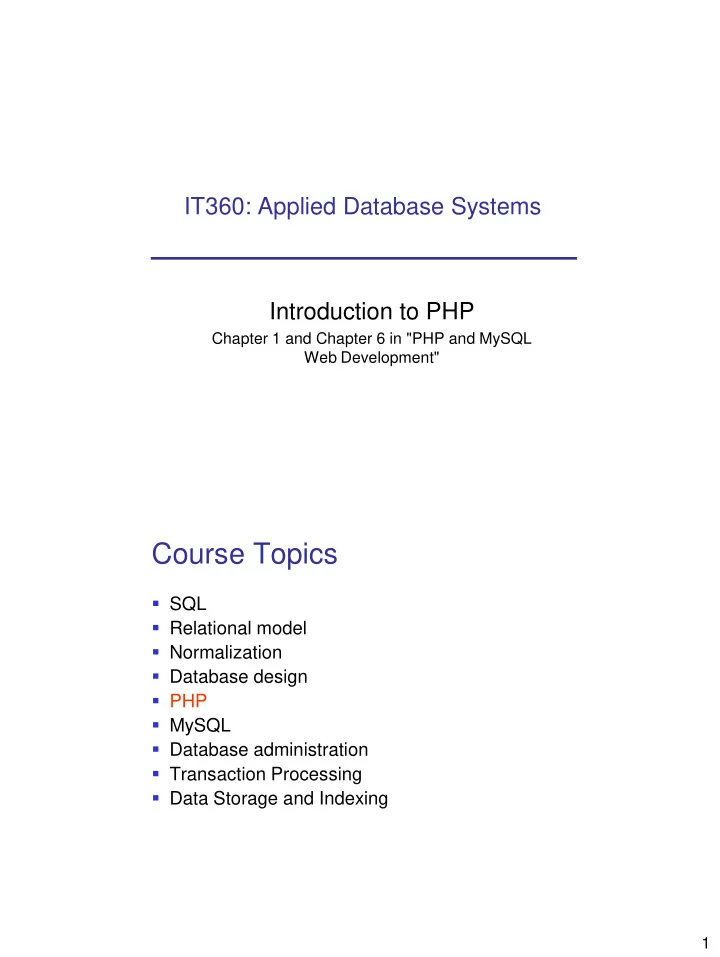

IT360: Applied Database Systems Introduction to PHP Chapter 1 and Chapter 6 in "PHP and MySQL Web Development" Course Topics SQL Relational model Normalization Database design PHP MySQL Database administration Transaction Processing Data Storage and Indexing 1
The Three-Tier Architecture Client Program (Web Browser) Presentation tier Middle tier Application Server Data management Database Management tier System, File Server Example 1: Airline reservations Build a system for making airline reservations Database System Application Server Client Program 2
Technologies Client Program (Web Browser) HTML, Javascript, XSLT C++, Cookies, XML, Application Server XPath, web services, Perl, PHP SQL, Triggers, Database Management Stored Procedures System Web Applications Need to choose: Operating system Web server software Database Management System Programming or scripting language 3
PHP PHP: PHP Hypertext Preprocessor Server-side scripting language PHP pages require a web server with PHP support Competitors: PHP Strengths High performance Interface to many different database systems Built-in libraries Ease of learning and use Object-oriented support Portability Open source Free Availability of support 4
PHP References Online references http://www.php.net Online Tutorial http://www.w3schools.com/php/default.asp PHP and MySQL Web Development by Luke Welling and Laura Thomson IT350 textbook: Internet & WWW How To Program by Deitel, Deitel, and Goldberg CGI – What does it all look like? 5
IT350 - CGI Script Basics Common Gateway Interface (CGI) “Common”: Not specific to any operating system or language Output file generated at runtime: 1. When a program executed as a CGI script, “standard output” is redirected to client Web server 2. Web server then redirects output to client's browser IT350 - How can CGI get data from user? Technique #1: Forms User enters data via a form, submits Form directs results to a CGI program Script receives data in one of two ways: 1. Method = “GET” 2. Method = “POST” Use language-specific method to get these inside CGI program Technique #2: URL with parameters <a href=http://www.cs.usna.edu/calendar/view.php?events=seminars> Seminars </a> 6
Form Processing PHP Overview PHP tags <?php ?> Mixed with HTML tags File extension .php Statements Separated by semicolon if..else.., while, do, for, switch Variables $varname Type determined by content; variables not declared; case sensitive Strings Single quotes – literal string Double quotes – interpolated string (variables are replaced with their value) Accessing form variables $_POST[‘age’], $_GET[‘age’], $_REQUEST[‘age’] 7
PHP Overview PHP objects Java-like inheritance public, private, or protected attributes and methods __construct(), __destruct(), __set(), __get() PHP functions function myFunction($param1, $param2){…} Files resource fopen( string $fileName, string $mode) int fwrite( resource $handle, string $someText) int fclose( resource $handle) string fgets( resource $handle) boolean feof (resource $handle ) How everything works: Step 1: Input Form – form.html <?xml version = "1.0" ?> <!DOCTYPE html PUBLIC "-//W3C//DTD XHTML 1.1//EN" "http://www.w3.org/TR/xhtml11/DTD/xhtml11.dtd"> <html><head><title>IT360 PHP test page</title></head> <body> <form action="processPersonInfo.php" method="post"> <p><label>Enter your name: <input type="text" name="name"/></label></p> <p><label>Enter your age: <input type="text" name="age" /></label></p> <p><input type="submit" name = "submit" value = "Submit"/></p> </form> </body> </html> 8
page.inc.php <?php class Page{ //attributes public $content; private $title; private $header = "<?xml version = '1.0' ?> <!DOCTYPE html PUBLIC '-//W3C//DTD XHTML 1.1//EN' 'http://www.w3.org/TR/xhtml11/DTD/xhtml11.dtd'>"; //constructor public function __construct($title){ $this->title = $title; } //set public attributes public function __set($name, $value){ $this->$name = $value; } //display page public function display(){ echo $this->header; echo "<head><title> $this->title </title></head>"; echo "<body>"; echo $this->content; echo "</body></html>"; } } //end class definition ?> Step 1 version 2 – getPersonInfo.php <?php //bring in the class definitions, //so we can use them require('page.inc.php'); //create a new page object $page = new Page("Input person"); //set the content: in needs to be a form $page->content = '<form action = "processPersonInfo.php" method = "post">'. '<p><label>Enter your name: <input type="text” name="name“/></label></p>’. ‘<p><label>Enter your age: <input type="text" name="age"/></label></p>’. '<input type = "submit" value = "submit">'; //display the page $page->display(); ?> 9
person.inc.php – part 1 <?php /* define a class Person with name and age */ class Person{ private $name; private $age; //constructor public function __construct(){} //default set function invoked when the private fields are set //this is a good place to do sanity/security checks public function __set($varName, $varValue) { $varValue = trim($varValue); $varValue = strip_tags($varValue); if (!get_magic_quotes_gpc()){ $varValue = addslashes($varValue); } $this->$varName = $varValue; } //default get function - nothing special for now public function __get($varName) { return $this->$varName; } person.inc.php – part 2 //return a string that contains the HTML code to get data for a person public static function getPersonAttributesAsHTMLInput() { $myString = '<p><label>Enter your name: <input type="text" name="name"/></label></p> <p><label>Enter your age: <input type="text" name="age" /></label></p>'; return $myString; } //process the person info to insert to file and display confirmation public function processPerson() { //write this person to the default file $success = $this->insertToFile(); //return a confirmation message if ($success){ $confirmation = '<h1>Thank you for registering with our site</h1>'. '<p>The information recorded is as follows: <br />'. "Name: $this->name <br /> Age: $this->age </p>"; } else{ $confirmation = '<h1>Error: we had problems with your registration (probably some file error - permissions??). Please try again.</h1>'; } return $confirmation; } 10
person.inc.php – part 3 /* save the content to a specified file or "persons.txt" if nothing is specified */ private function insertToFile($fileName="persons.txt") { $fp = @fopen($fileName, 'a'); if (!$fp){ return false; } else{ $text = "$this->name\t$this->age\n"; fwrite($fp, $text); fclose($fp); return true; } } person.inc.php – part 4 /*read all info from file and return it in some nice format */ public static function getAllPersonsInfo($fileName = "persons.txt"){ //read the data from file and construct the content $fp = @fopen($fileName, 'r'); //check for errors if (!$fp){ $content = "<p>ERROR! Could not open file $fileName for reading.</p>"; } //if everything OK, read the file else{ $content= '<p>Here is the list: <br />'; //read one line $line = fgets($fp); while( !feof($fp) ){ //process the line $content .= $line . '<br />'; //read next line $line = fgets($fp); } $content .= '</p>'; //close the file fclose($fp); } return $content; } }?> 11
Recommend
More recommend